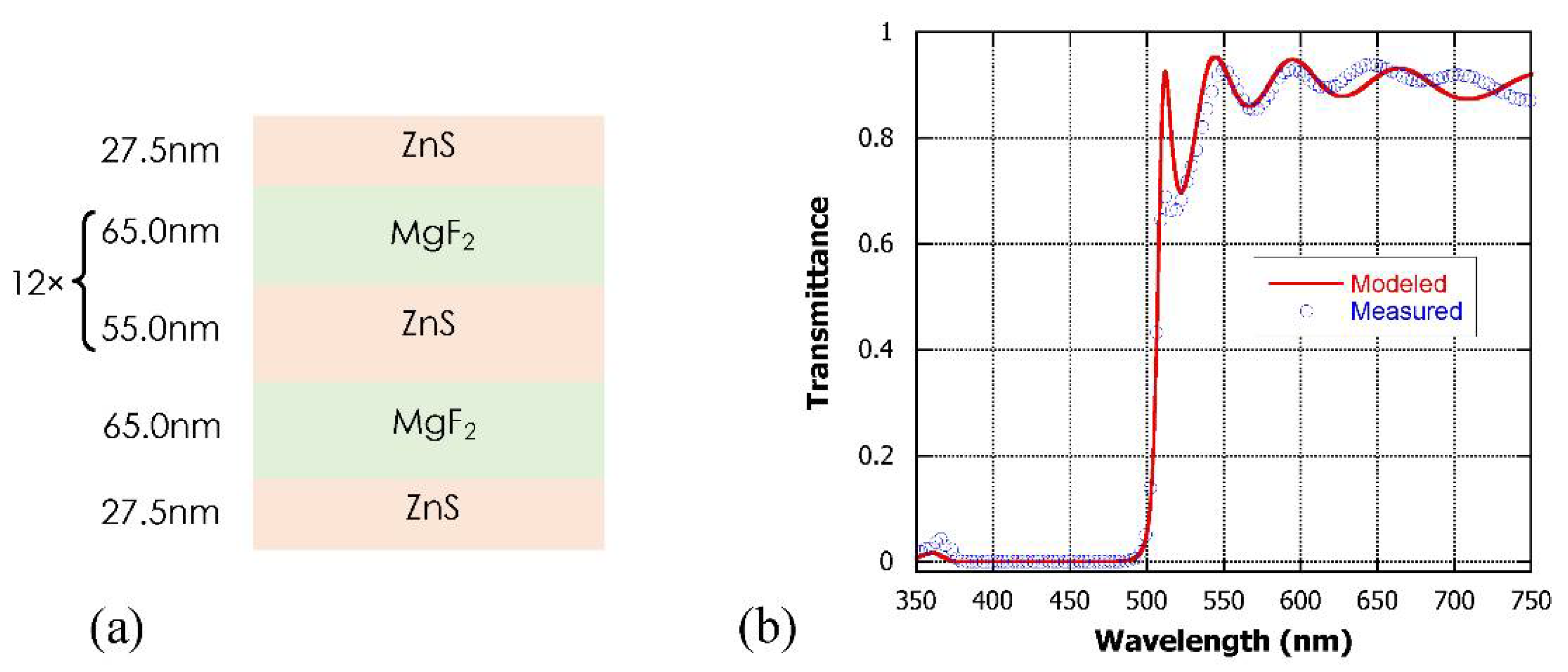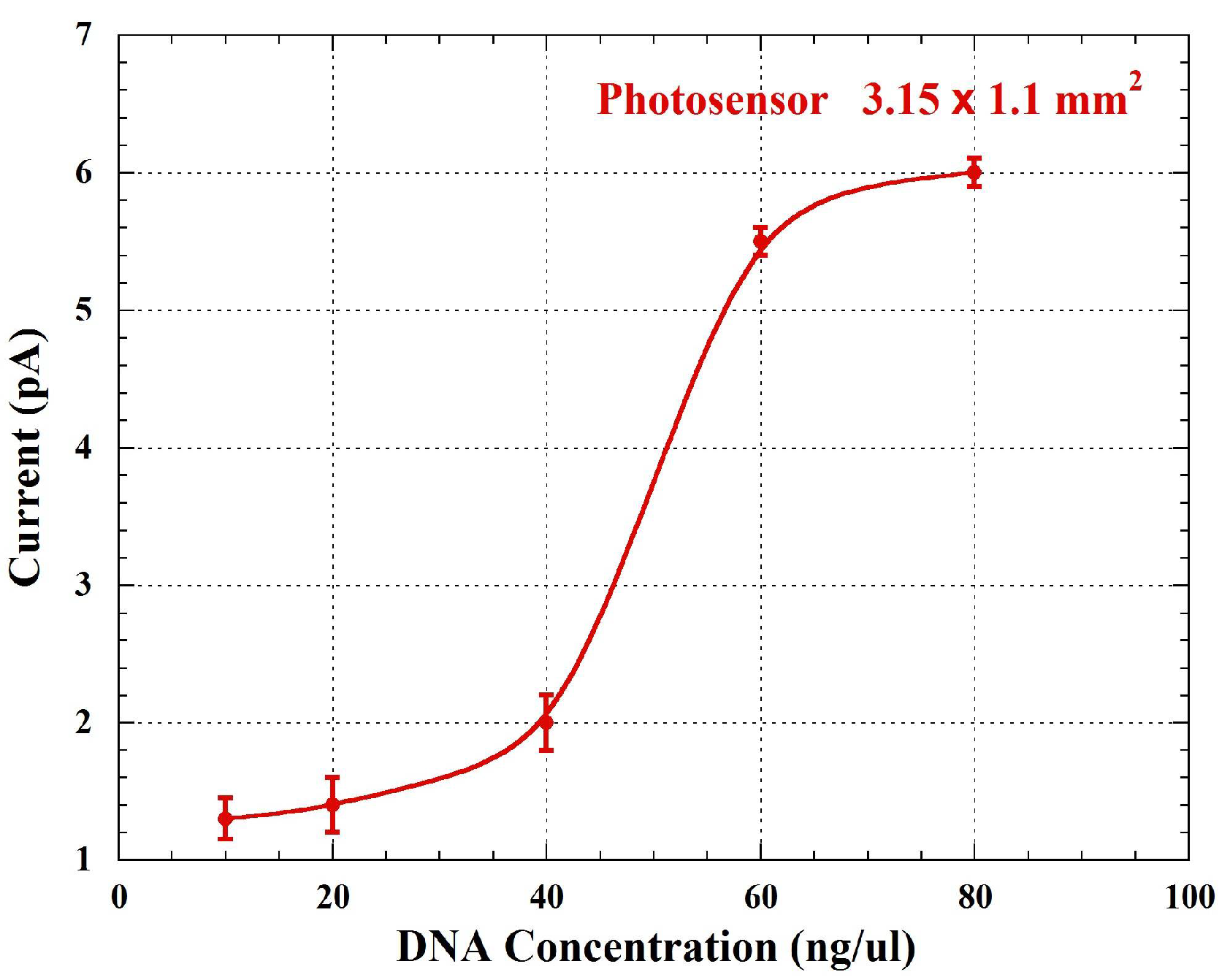On-Glass Optoelectronic Platform for On-Chip Detection of DNA †
Abstract
:1. Introduction
2. Materials and Methods
2.1. a-Si:H Photosensor Fabrication
2.2. Filter Fabrication
2.3. Microfluidic Network Fabrication
3. Results and Discussion
4. Conclusions
Author Contributions
Acknowledgments
Conflicts of Interest
References
- Schena, M. Microarray Analysis; John Wiley & Sons: Hoboken, NJ, USA, 2003. [Google Scholar]
- Munster, V.; Wallensten, A.; Olsen, B.; Rimmelzwaan, G.F.; Osterhaus, A.D.M.E.; Fouchier, R.A.M. Influenza A Virus Surveillance in Wild Birds. In Avian Influenza: Prevention and Control; Schrijver, R.S., Koch, G., Eds.; Springer: Dordrecht, The Netherlands, 2005; Chapter 4; pp. 25–30. [Google Scholar]
- Butler, J.M. Advanced Topics in Forensic DNA Typing: Methodology; Academic Press: Cambridge, MA, USA, 2011. [Google Scholar]
- Wongkaew, N.; He, P.; Kurth, V.; Surareungchai, W.; Baemner, A.J. Multi-channel PMMA microfluidic biosensor with integrated IDUAs for electrochemical detection. Anal. Bioanal. Chem. 2013, 405, 5965–5974. [Google Scholar] [CrossRef]
- Waggoner, P.S.; Craighead, H.G. Micro- and nanomechanical sensors for environmental, chemical, and biological detection. Lab Chip 2007, 7, 1238–1255. [Google Scholar] [CrossRef]
- Pires, N.M.M.; Dong, T.; Hanke, U.; Hoivik, N. Recent Developments in Optical Detection Technologies in Lab-on-a-Chip Devices for Biosensing Applications. Sensors 2014, 14, 15458–15479. [Google Scholar] [CrossRef] [PubMed]
- Bruijns, B.B.; Tiggelaar, R.M.; Gardeniers, J.G. Fluorescent cyanine dyes for the quantification of low amounts of dsDNA. Anal. Biochem. 2016, 511, 74–79. [Google Scholar] [CrossRef] [PubMed]
- Petrucci, G.; Caputo, D.; Lovecchio, N.; Costantini, F.; Legnini, I.; Bozzoni, I.; Nascetti, A.; de Cesare, G. Multifunctional system-on-glass for Lab-on-chip applications. Biosens. Bioelectron. 2017, 93, 315–321. [Google Scholar] [CrossRef] [PubMed]
- Satyanarayana, S.; Karnik, R.N.A.; Majumdar, A. Stamp-and-stick room-temperature bonding technique for microdevices. J. Microelectromechanical Syst. 2005, 14, 392–399. [Google Scholar] [CrossRef]
- Costantini, F.; Sberna, C.; Petrucci, G.; Reverberi, M.; Domenici, F.; Fanelli, C.; Manetti, C.; de Cesare, G.; Derosa, M.; Nascetti, A.; et al. Aptamer-based sandwich assay for on chip detection of Ochratoxin A by an array of amorphous silicon photosensors. Sens. Actuators B Chem. 2016, 230, 31–39. [Google Scholar] [CrossRef]
- Caputo, D.; Costantini, F.; Lovecchio, N.; Viri, V.; Tucci, M.; Mangiapane, P.; Ruggi, A.; Petrucci, G.A.; Nascetti, A.G.; de Cesare, G. Highly miniaturized system for on-chip detection of DNA. In Proceedings of the 20th International Conference on Miniaturized Systems for Chemistry and Life Sciences, Dublin, Ireland, 9–13 October 2016; pp. 1234–1235. [Google Scholar]
- Jiang, Y.; Fang, X.; Bai, C. Signaling aptamer/protein binding by a molecular light switch complex. Anal. Chem. 2004, 76, 5230–5235. [Google Scholar] [CrossRef] [PubMed]
- Available online: http://www.esrf.eu/Instrumentation/software/data-analysis/xop2.4 (accessed on 21 September 2017).



Publisher’s Note: MDPI stays neutral with regard to jurisdictional claims in published maps and institutional affiliations. |
© 2018 by the authors. Licensee MDPI, Basel, Switzerland. This article is an open access article distributed under the terms and conditions of the Creative Commons Attribution (CC BY) license (https://creativecommons.org/licenses/by/4.0/).
Share and Cite
Caputo, D.; Costantini, F.; Lovecchio, N.; Nardecchia, M.; Nascetti, A.; Cesare, G.d. On-Glass Optoelectronic Platform for On-Chip Detection of DNA. Proceedings 2018, 2, 1014. https://doi.org/10.3390/proceedings2131014
Caputo D, Costantini F, Lovecchio N, Nardecchia M, Nascetti A, Cesare Gd. On-Glass Optoelectronic Platform for On-Chip Detection of DNA. Proceedings. 2018; 2(13):1014. https://doi.org/10.3390/proceedings2131014
Chicago/Turabian StyleCaputo, Domenico, Francesca Costantini, Nicola Lovecchio, Marco Nardecchia, Augusto Nascetti, and Giampiero de Cesare. 2018. "On-Glass Optoelectronic Platform for On-Chip Detection of DNA" Proceedings 2, no. 13: 1014. https://doi.org/10.3390/proceedings2131014
APA StyleCaputo, D., Costantini, F., Lovecchio, N., Nardecchia, M., Nascetti, A., & Cesare, G. d. (2018). On-Glass Optoelectronic Platform for On-Chip Detection of DNA. Proceedings, 2(13), 1014. https://doi.org/10.3390/proceedings2131014






